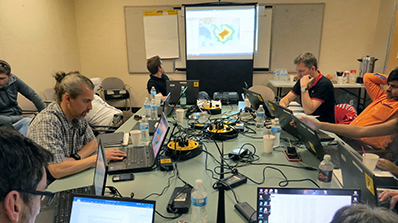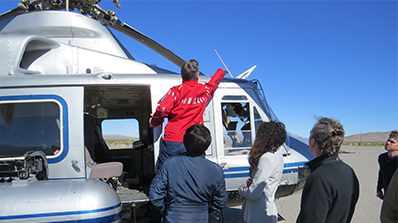Recently, the U.S. Department of Energy (DOE) Aerial Measuring System (AMS) conducted a series of joint surveys with the Norwegian Radiation Protection Authority (NRPA). The goal was to compare the responses of the two agencies’ aerial radiation detection systems and data processing techniques. These surveys were flown over selected natural background areas near Las Vegas and varied radioactive surface contamination areas at the Nevada National Security Site (NNSS) including Areas 3, 8, 11 and 30. For the comparison, both teams used their agencies’ deployable aerial radiation detections systems. Both systems were flown on the DOE Bell 412 helicopter with AMS’ in externally mounted dedicated pods and the NRPA system inside, mounted to the helicopter floor.
This was AMS’ sixth joint survey with international partners. The first was conducted in 2007 with the French Alternative Energies and Atomic Energy Commission Helinuc. Subsequent surveys have been conducted with the British Atomic Weapons Establishment (AWE) in 2010, Israel Atomic Energy Commission in 2013, Natural Resources Canada (NRCan) in 2014, and another French team from the Institute for Radiological Protection and Nuclear Safety (IRSN) in 2017.
In parallel to the joint survey, AMS hosted an advanced data analysis workshop for selected countries or organizations: Norwegian NRPA, French IRSN, Taiwan Atomic Energy Council and the Canadian NRCan, with observers from the International Atomic Energy Agency (IAEA) Response and Assistance Network (RANET). Workshop participants performed analysis of data collected during joint surveys under the supervision of AMS data scientists using AMS techniques. The data workshop was of special interest to RANET personnel, as it provided an opportunity for a group of international subject-matter experts to work together analyzing and producing joint products, much like what would be necessary in the event of an international request for assistance rendered by the IAEA.

Both events were sponsored by the NNSA Office of Nuclear Incident Policy and Cooperation to help improve and validate AMS methodology. According to the Office’s director, Ann Heinrich, engaging international partners has tremendous return on investment in supporting long-term national security goals, establishing strategic relationships with regard to radiological/nuclear terrorism threats, enhancement of technical tools, policy development, and practical approaches to strengthen U.S. (and global) preparedness.
The data collected by each team will be included in the final report written by NRPA, with the first discussion of results scheduled for June 2018 during the 6th AMS International Technical Exchange in Las Vegas, and final report discussion scheduled for spring 2019, with the U.S. delegation visit to NRPA.

